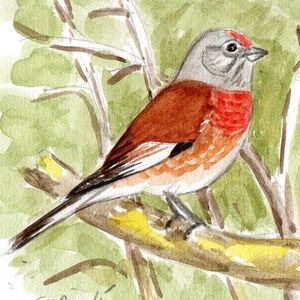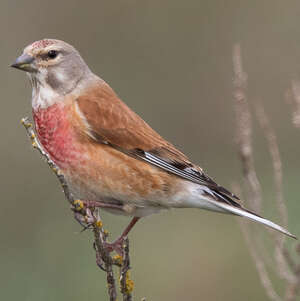Common Linnet
Linaria cannabina - Linotte mélodieuse
Identification
The Common Linnet is a small finch whose nuptial male is easy to identify by its plumage. As the spring advances, its plumage becomes worn, revealing the underlying vivid colors, particularly the scarlet red on its forehead and breast. Often, the red colour on the breast is split down the middle by a pale band which extends to the white belly. The head is grey with pale whitish areas around the dark eyes, around the lores, and on either side of the throat. A faint pale eyebrow may sometimes appear. A darker grey patch lies below the eye. The upperparts (body and wing-coverts) are a warm light brown. The primaries and rectrices are especially white-tinged, which can be seen when perched, but becomes obvious when flying. The flanks are rufous, the undertail coverts white. The beak is grey. The legs are reddish to brownish. The adult female resembles the male but is more dull in colour and lacks the red tones. Her plumage is distinctly striped above (mantle and coverts) and below (breast and flanks). The head remains grey, with the same pattern, but the cap is striped. The juvenile resembles the female, but is overall more rufous and is even more striped. Its head is not grey but brown, and the pale areas are rufous.
Subspecific information 7 subspecies
- Linaria cannabina cannabina (w, c and n Europe, w and sc Siberia)
- Linaria cannabina autochthona (Scotland)
- Linaria cannabina bella (Middle East to Mongolia and nw China)
- Linaria cannabina mediterranea (Iberian Pen., Italy, Greece, nw Africa and Mediterranean islands)
- Linaria cannabina guentheri (Madeira I.)
- Linaria cannabina meadewaldoi (w and c Canary Is.)
- Linaria cannabina harterti (e Canary Is.)
Foreign names
- Linotte mélodieuse,
- Pardillo común,
- pintarroxo-de-bico-escuro,
- Bluthänfling,
- kenderike,
- Kneu,
- Fanello,
- hämpling,
- Tornirisk,
- stehlík konôpka,
- konopka obecná,
- Tornirisk,
- hemppo,
- passerell comú,
- Hörfinka,
- makolągwa (zwyczajna),
- kaņepītis,
- repnik,
- Коноплянка,
- ムネアカヒワ,
- 赤胸朱顶雀,
- hämpling,
- 朱胸朱頂雀,
Voice song and call
The male's song is a musical phrase consisting of a rapid, even precipitous, succession of varied notes, some sweet and some harsher, with no stereotyping. The song starts fairly slowly then accelerates into a succession of very varied notes, staccato, mellow, whistled, rolled, trilled, etc. The phrase is untranscribable. It is its length, rhythm, sound, variety and tonality of notes that make it so distinctive. The beginner will simply avoid confusion with the song of the Eurasian Siskin. The cries have the same tonality as the notes of the song and the same precipitous issue. For example, flight cries, frequently emitted during movement to keep contact, have a cutting edge that differentiates them from those of the Eurasian Siskin, more mellow.
Habitat
The Common Linnet is a common bird that inhabits all sorts of open to semi-open environments. The substrate is irrelevant, ranging from hydromorphic to arid areas.
Behaviour character trait
The Common Linnet is a highly mobile bird, like many other finches. During the breeding season, male and female move together from one food source to another or to the nearest source of water, making contact calls along the way.
This same behaviour applies to nest building or feeding of large young. After breeding, from August, the species becomes gregarious and forms small migrating groups that can include up to several dozen birds, foraging on the ground for seeds. The species is partially migratory. Southern linnets are sedentary or at least erratic, while those in the north and northeast of Europe are migratory. They are quite late migrants, for example they are seen on migration watch sites in October or later. They always travel in small, rather loose groups, unlike for example the Bramblings' more compact groups. They stop in fields along with two species of the finches, Siskins, Greenfinches, Twite etc., and it is in such places that one can encounter the biggest gatherings of Common Linnets. The presence of the species in the winter depends on the availability of small seeds which they feed upon. A heavy blanket of snow will drive them away or concentrate them in the favourable places that persist. Unlike Goldfinches, Chaffinches, Greenfinches and other finches, the Common Linnet is not known to frequent winter feeding stations. Sunflower seeds are likely too big for it, but this probably has more to do with its independent nature. Migration of the migrants is also late, most passing through in April or even May.Flight
The flight of the Common Linnet is typical of a finch. It is a wavelike flight resulting from the alternation of quick and vigorous wing beats and brief resting periods with wings closed. The flight is direct and fast, punctuated by the small cries mentioned above. During the breeding season, the couple will move together until they are burdened with family. During the cold season, Linnets are always in tight groups for movement.
Dietfeeding habits
The Common Linnet is a granivorous species. It consumes small to medium sized seeds of all kinds, from trees like birches and alders, where it is joined by siskins and goldfinches, to shrubs with berries (tutsans, buckthorns.
but especially of multiple herbaceous plants of many families (poaceae, chenopodiaceae, polygonaceae, asteraceae...). In the very first days of their life, chicks are also fed with insect larvae, but they quickly switch to an exclusive granivorous diet. During the summer, the seeds are sought in the herbaceous strata, while in winter the search is directly on the ground, which the birds progress on with small hops.Reproduction nesting
The return to breeding grounds is relatively late, from mid-April in the south to late May in the Northeast of the range.
Common Linnet is monogamous. The couple that forms then is united for the season. Two successive broods are typical, a third one may occur in the south when conditions are favourable. The male defends a rather restricted territory including the site of the future nest, which allows other couples in the neighbourhood and permits semi-colonial reproduction if necessary. The search for food is done outside the territory, sometimes quite far from the nest. After some parades aimed at strengthening the couple, the female builds the nest alone at the bottom of a dense and often thorny bush, sloe bush, bramble... The male only accompanies her while singing. The nest is a cup made of twigs, small roots, vegetable fibres, moss, and lined inside with soft elements like sheep's wool or feathers. The laying is of 4 to 6 pale eggs, sometimes a bit bluish, slightly spotted with brown-pink and with some clear dark spots at the big end. The female incubates alone for about 12 days. The couple feeds the young in the nest for about 15 days, and even a few days after they fledge. But the female often quickly reinvest in a second reproduction, which makes it mainly the male who takes charge of the flying young. The female builds a new nest as the old one, covered with droppings, is no longer suitable for laying.Geographic range
The Common Linnet is a bird of the Western Palearctic. It breeds at temperate latitudes of the Atlantic coast (from Ireland to Morocco) and in the center of Russia. In the north, it is only present in the south of Fenno-Scandia. To the south it nests around the Mediterranean, in Anatolia, the Caucasus, south of the Caspian Sea and in the mountains of Central Asia, such as the Tianshan. The birds in the northeast of the range are migratory and come to spend the winter in the south of the breeding range, where the native birds are sedentary or wandering. The migrants rarely venture onto the African continent. On the other hand, eastwards they descend as far as the Persian Gulf and the Red Sea.
Threats - protection
IUCN conservation status
concern
in the Wild
threatened
evaluated
The Common Linnet is a common and locally numerous species. It is not threatened. In the past it was captured for consumption, like so many other species, but now it is protected by French law. As for the well-known expression tête de linotte, it must date from the time when the little birds were trapped. Groups of linnets had to come down to the glue, attracted by the food, and stick to the glue. And as they are very social birds, they had to get caught until the last, unaware of the danger.
Sources of information
- IOC World Bird List (v15.1), Gill, F and D Donsker (Eds). 2025-12-07.
- Les passereaux d'Europe, tome 2, P. Géroudet, M. Cuisin
- Birds of the World, The Cornell Lab of Ornithology
- xeno-canto, Sharing bird sounds from around the world,
Other sources of interest
 Specification sheet created on
12/07/2023 by Jean François
Specification sheet created on
12/07/2023 by Jean FrançoisTranslation by AI Oiseaux.net
© 1996-2025 Oiseaux.net
- Accipitriformes
- Aegotheliformes
- Anseriformes
- Apodiformes
- Apterygiformes
- Bucerotiformes
- Caprimulgiformes
- Cariamiformes
- Casuariiformes
- Charadriiformes
- Ciconiiformes
- Coliiformes
- Columbiformes
- Coraciiformes
- Cuculiformes
- Eurypygiformes
- Falconiformes
- Galliformes
- Gaviiformes
- Gruiformes
- Leptosomiformes
- Mesitornithiformes
- Musophagiformes
- Nyctibiiformes
- Opisthocomiformes
- Otidiformes
- Passeriformes
- Pelecaniformes
- Phaethontiformes
- Phoenicopteriformes
- Piciformes
- Podargiformes
- Podicipediformes
- Procellariiformes
- Psittaciformes
- Pterocliformes
- Rheiformes
- Sphenisciformes
- Steatornithiformes
- Strigiformes
- Struthioniformes
- Suliformes
- Tinamiformes
- Trogoniformes


































